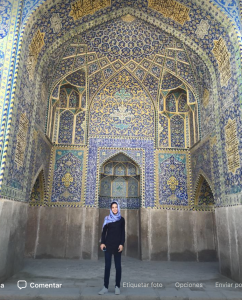Over the last few weeks, our ASTU class read and analyzed “Persepolis” by Marjane Satrapi. (If you haven’t read it, I strongly recommend it.) While discussing this “Graphic Narrative” (Chute and DeKoven) in class, we got to the conclusion that Satrapi wants us (the readers) to understand the way Iranians live; that they are people too and not all of them are extremists, like the media claims they are.
My trip to Iran
My family and I went to Iran in 2015. I remember that all of my family (grandparents, cousins, uncles, etc) and friends were truly concerned about that trip of ours. Most of them called us “crazy”. A friend of mine actually asked me if I had a death wish. To be completely honest, I was quite scared of going there too. I had the idea that Iran was just like they said in the media…
I remember that we were on the plane from Dubai to Tehran, and I was sitting next to an Iranian girl that was about my age. We started talking, and she began to tell me about her culture and country. I was surprised to what I was hearing, she didn’t mention anything about terrorists or war. By the end of the flight, I had a totally new perspective about the country I was about to visit.
It would take me forever to talk about my wonderful experience in this country. However I do want to mention one day of this holiday that reminded me so much about Satrapi’s purpose of writing the book. After visiting the “Jardín de Fín” in Kashan, the tour guide thought it was a good idea to take us to a place that sold local/typical bread from Iran that was just around the corner. I can’t remember the context really well, but I remember that the person selling the bread drew a heart on the bread and gave us the bread for free. He didn’t accept the money and he had the biggest smile on his face. Just after that, my family, the tour guide and I hopped into the van, then the tour guide said “Not all Iranians are terrorists, just like not all Mexicans are drug dealers.” That really hit me. The media had given us an awful idea about Iran and it was the complete opposite. Most of the people we got to meet were really friendly, just like the baker; my family and I felt really safe when walking around the city; I didn’t get to see a single gun or hear an explosion.

The Media
As I mentioned before, I had the idea that Iran was a totally different country due to the media. Bush’s “Axis of Evil” harshly targeted Iran among other countries ( speech on: https://www.nytimes.com/video/us/politics/100000004021075/the-axis-of-evil-speech.html). The thing is that the media hasn’t stopped . Just out of curiosity I typed “Iran news” on Google, and the first thing that came up was a picture of a man holding a gun (https://www.aljazeera.com/news/2018/10/sanctions-network-supporting-iran-basij-resistance-force-181016181132789.html). The problem is that I was not the only one that had a negative thought on Iran; 58% of the world (2015) had a negative opinion of this country( http://www.pewglobal.org/2015/06/18/irans-global-image-mostly-negative/).
The media has managed to manipulate us to believe the conditions they want us to think. However, we need to engage differently by being more critical with how we understand the news.
Conclusion
One of Satrapi’s purposes of writing “Persepolis” was to show the readers that not all Iranians are extremists. Due to the media, that is the only impression some people have of Iran. Iran is not the only country facing this problem, many countries are, just like my home, Mexico. While I was studying abroad, our Geography teacher played us a video about pollution in different countries. They mentioned that Shanghai had a lot of pollution due to cars but that they were solving the problem by creating a really fast train. On the other hand, Mexico faced a problem that they had a really polluted river, that it even had a dead body in it. After the video, my friends didn’t even remember the fact that we had a pollution problem, they were just worried about the dead body in the river. The thing is that I go past that river quite often and I have never seen something like that. The news have way more negative coverages rather than positive ones. They go by the policy “If it bleeds, it leads” (https://www.theguardian.com/commentisfree/2018/feb/17/steven-pinker-media-negative-news). A solution for this problem would be to stop believing the media is an objective source of knowledge. I mean, “news” only gives us a small frame, usually negative, of what is actually going on in some countries. We have to be more subjective, know different points of view, be more informed about it, before we criticize or allow the news to carry us away.